In alphabetical order.

Yashar Akrami (2018-2021)
PhD: Oskar Klein Center (Stockholm); Postdocs: Leiden University, Heidelberg University, University of Oslo.
Yashar is a theoretical physicist specialised in cosmology and particle physics, with a broad range of interests. He has also a strong interest in cosmological data analysis and his focus is on the interplay between cosmological observations and fundamental physics.
Yashar is interested in questions related to the physics of the early universe and cosmic initial conditions, late-time cosmic acceleration and dark energy, theories of gravity on the largest scales, signatures of new physics beyond standard models of cosmology and particle physics, and implications of high energy theories (quantum gravity, string theory, supergravity) for cosmology.
On the observational side, he is interested in the cosmic microwave background, large-scale structure of the universe, and statistical inference and high-performance computing techniques in cosmology and particle physics. He is an active member of the Planck Collaboration, Euclid Consortium, and the Square Kilometre Array (SKA).
Selected publications
![]() Akrami, Casas, Deng, Vardanyan: Quintessential α-attractor inflation: forecasts for Stage IV galaxy surveys (2020)
Akrami, Casas, Deng, Vardanyan: Quintessential α-attractor inflation: forecasts for Stage IV galaxy surveys (2020)
![]() Chartier, Wandelt, Akrami, Villaescusa-Navarro: CARPool: fast, accurate computation of large-scale structure statistics by pairing costly and cheap cosmological simulations (2020)
Chartier, Wandelt, Akrami, Villaescusa-Navarro: CARPool: fast, accurate computation of large-scale structure statistics by pairing costly and cheap cosmological simulations (2020)
![]() Akrami et al.: Planck intermediate results. LV. Reliability and thermal properties of high-frequency sources in the Second Planck Catalogue of Compact Sources (Planck Collaboration, 2020)
Akrami et al.: Planck intermediate results. LV. Reliability and thermal properties of high-frequency sources in the Second Planck Catalogue of Compact Sources (Planck Collaboration, 2020)
![]() Akrami, Sasaki, Solomon, Vardanyan: Multi-field dark energy: cosmic acceleration on a steep potential (2020)
Akrami, Sasaki, Solomon, Vardanyan: Multi-field dark energy: cosmic acceleration on a steep potential (2020)
![]() SKA Collaboration (2018): Cosmology with Phase 1 of the Square Kilometre Array: Red Book 2018: Technical specifications and performance forecasts. Submitted to Publ. Astron. Soc. Austral. [arXiv:1811.02743].
SKA Collaboration (2018): Cosmology with Phase 1 of the Square Kilometre Array: Red Book 2018: Technical specifications and performance forecasts. Submitted to Publ. Astron. Soc. Austral. [arXiv:1811.02743].
Full list: https://inspirehep.net/author/profile/Y.Akrami.2
More information: https://www.yashar-akrami.com/

Badih Assaf (2014-2018) / Currently Assistant Professor, University of Notre Dame (Indiana, US)
BS: American University of Beirut; Graduate student at Northeastern University in Heiman group and visiting scientist at MIT with the Moodera group
Badih’s research interests are primarily focused on studying and understanding the electronic properties of 2D materials and topological insulators. The most common 2D material is graphene which is essentially a single atomic sheet of carbon. Topological insulators, on the other hand, are 3D materials that are semiconducting in the bulk but highly conducting on the surface. Such materials are extremely attractive as potential silicon alternatives in data processing devices as well as for applications in memory devices and optoelectronics.
His PhD involved quantum coherent transport in topological insulator thin films grown by molecular beam epitaxy, along with studying the properties of novel spin-gapless Heusler alloys.
As a JRC, he worked on probing the fundamental electronic properties of 2D materials as well as different topological material systems (Bi2Se3, Bi2Te3…) using gigahertz transport probes and terahertz spectroscopy.
Selected Publications
![]() G. Krizman, B.A. Assaf, T. Phuphachong, G. Bauer, G. Springholz, G. Bastard, R. Ferreira, L.A. de Vaulchier, Y. Guldner. “Tunable Dirac interface states in topological superlattices” Phys. Rev. B 98 075303 (2018).
G. Krizman, B.A. Assaf, T. Phuphachong, G. Bauer, G. Springholz, G. Bastard, R. Ferreira, L.A. de Vaulchier, Y. Guldner. “Tunable Dirac interface states in topological superlattices” Phys. Rev. B 98 075303 (2018).
![]() A. Inhofer, J. Duffy, M. Boukhicha, E. Bocquillon, J. Palomo, K. Watanabe, T. Taniguchi, I. Estève, J.M. Berroir, G. Fève, B. Plaçais, B.A. Assaf. “RF compressibility of topological insulator Bi2Se3 in the bulk depleted regime”, Physical Review Applied 9 024022 (2018).
A. Inhofer, J. Duffy, M. Boukhicha, E. Bocquillon, J. Palomo, K. Watanabe, T. Taniguchi, I. Estève, J.M. Berroir, G. Fève, B. Plaçais, B.A. Assaf. “RF compressibility of topological insulator Bi2Se3 in the bulk depleted regime”, Physical Review Applied 9 024022 (2018).
![]() B.A. Assaf, T. Phuphachong, E. Kampert, V. Volobuev, P. Mandal, J. Sanchez-Barriga, O. Rader, G. Bauer, G. Springholz, L.A. de Vaulchier, Y. Guldner, “Negative magnetoresistance from anomalous N=0 Landau level in topological matter”. Physical Review Letters 119, 106602 (2017).
B.A. Assaf, T. Phuphachong, E. Kampert, V. Volobuev, P. Mandal, J. Sanchez-Barriga, O. Rader, G. Bauer, G. Springholz, L.A. de Vaulchier, Y. Guldner, “Negative magnetoresistance from anomalous N=0 Landau level in topological matter”. Physical Review Letters 119, 106602 (2017).
https://www.linkedin.com/in/badih-a-assaf-3b57bb77/
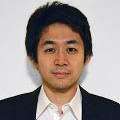
Tatsuo Azeyanagi (2013-2016) / Currently Data scientist at D2C, a digital marketing and advertising company (Japan)
PhD: Kyoto University (2011); Postdoc at ENS; Postdoc at University of Brussels (ULB) (2017-2020)
His main research interests were:
![]() string theory and quantum field theories (RIKEN)
string theory and quantum field theories (RIKEN)
![]() microscopic analysis of black holes based on string theory and gauge/gravity dualities
microscopic analysis of black holes based on string theory and gauge/gravity dualities
![]() large-N gauge theories, matrix models and their relations to string/M theory.
large-N gauge theories, matrix models and their relations to string/M theory.
He now carries out research on machine learning algorithms, applying them for digital marketing and online advertisement.
Selected publications
![]() "The Spectrum of Strings on Warped AdS3xS3," Tatsuo Azeyanagi, Diego M. Hofman, Wei Song and Andrew Strominger, arXiv:1207.5050[hep-th]
"The Spectrum of Strings on Warped AdS3xS3," Tatsuo Azeyanagi, Diego M. Hofman, Wei Song and Andrew Strominger, arXiv:1207.5050[hep-th]
![]() "Large-N reduction in QCD-like theories with massive adjoint fermions," Tatsuo Azeyanagi, Masanori Hanada, Mithat Unsal and Ran Yacoby, Phys.Rev.D82(2010)125013
"Large-N reduction in QCD-like theories with massive adjoint fermions," Tatsuo Azeyanagi, Masanori Hanada, Mithat Unsal and Ran Yacoby, Phys.Rev.D82(2010)125013
![]() "Higher-Derivative Corrections to the Asymptotic Virasoro Symmetry of 4d Extremal Black Holes," Tatsuo Azeyanagi, Geoffrey Compere, Noriaki Ogawa, Yuji Tachikawa and Seiji Terashima, Prog.Theor.Phys.122(2009)355-384
"Higher-Derivative Corrections to the Asymptotic Virasoro Symmetry of 4d Extremal Black Holes," Tatsuo Azeyanagi, Geoffrey Compere, Noriaki Ogawa, Yuji Tachikawa and Seiji Terashima, Prog.Theor.Phys.122(2009)355-384
https://www.linkedin.com/in/tatsuo-azeyanagi/
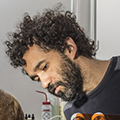
Hilton Barbosa de Aguiar (2016-2020) / Currently permanent PI at the Laboratoire Kastler-Brossel (Paris, France)
PhD: EPFL/Lausanne, jointly with Max-Planck Institute/Stuttgart; Postdoc: Stuttgart University, Stuttgart; Fresnel Institut, Marseille
Hilton is an experimentalist working on the development and applications of nonlinear microscopy and spectroscopy tools for probing complex soft matter systems.
After a PhD focused on using interface-specific nonlinear spectroscopy tools for unravelling molecular level details of colloidal particle interfaces, he worked on nonlinear imaging of biological systems, with particular emphasis in challenging scattering systems.
As a JRC, he started novel research lines on the merging of signal processing and microscopy, so-called computational microscopy, for biomedical imaging applications. He is now a CNRS researcher at the Laboratoire Kastler-Brossel in the group Complex Media Optics Lab. All in all, the advanced tools are based on label-free approaches exploiting the intrinsic vibrational response of molecular systems.
Selected publications
![]() J. Guilbert, A. Negash, S. Labouesse, S. Gigan, A. Sentenac., H. B. de Aguiar, Label-free super-resolution chemical
J. Guilbert, A. Negash, S. Labouesse, S. Gigan, A. Sentenac., H. B. de Aguiar, Label-free super-resolution chemical
imaging of biomedical specimens. bioRXiv:10.1101/2021.05.14.444185.
![]() A. Boniface, M. Mounaix, B. Blochet, H. B. de Aguiar, F. Quéré, S. Gigan, Spectrally resolved point-spread-function
A. Boniface, M. Mounaix, B. Blochet, H. B. de Aguiar, F. Quéré, S. Gigan, Spectrally resolved point-spread-function
engineering using a complex medium . Opt. Express 29 (2021), 8985–8996.
![]() Y. Zhang, H. B. de Aguiar, J. T. Hynes, D. Laage. Water structure, dynamics and sum-frequency generation
Y. Zhang, H. B. de Aguiar, J. T. Hynes, D. Laage. Water structure, dynamics and sum-frequency generation
spectra at electrified graphene interfaces. J. Phys. Chem. Lett. 11 (2020), 624–631.
![]() S. Pullanchery, S. Kulik, H. I. Okur, H. B. de Aguiar, S. Roke On the stability and necessary electrophoretic mobility of bare oil nanodroplets in water. J. Chem. Phys. 152 (2020), 241104.
S. Pullanchery, S. Kulik, H. I. Okur, H. B. de Aguiar, S. Roke On the stability and necessary electrophoretic mobility of bare oil nanodroplets in water. J. Chem. Phys. 152 (2020), 241104.
http://www.lkb.upmc.fr/opticalimaging/
https://hiltonbarbosa.wixsite.com/deaguiar
 Thomas Boulier (2020-2022) / currently Junior Professor at INSA (Toulouse)
Thomas Boulier (2020-2022) / currently Junior Professor at INSA (Toulouse)
After a PhD at ENS- LKB in 2014, Thomas occupied international postdoctoral positions: Joint Quantum Institute (USA), ETHZ (Switzerland) and LCF (Palaiseau, France).
Thomas is an experimental quantum physicist interested in many subjects within quantum optics, condensed matter and AMO physics, with a special interest in Rydberg physics.
His research activities focus on exploring systems of many bosonic particles in strong interaction, and on optically exploiting them to give interactions to photons. He has been working with two types of systems: exciton-polaritons in semiconductors and ultra-cold Rydberg atoms in optical lattices.
Selected Publications
![]() C. Morin, J. Tignon, J. Mangeney, S. Dhillon, G. Czajkowski, K. Karpiński, S. Zielińska-Raczyńska, D. Ziemkiewicz, and T. Boulier, Self-Kerr Effect across the Yellow Rydberg Series of Excitons in Cu2O
C. Morin, J. Tignon, J. Mangeney, S. Dhillon, G. Czajkowski, K. Karpiński, S. Zielińska-Raczyńska, D. Ziemkiewicz, and T. Boulier, Self-Kerr Effect across the Yellow Rydberg Series of Excitons in Cu2O
Phys. Rev. Lett. 129, 137401 – Published Sept. 2022
![]() T. Boulier, J Maslek, M Bukov, C Bracamontes, E Magnan, S Lellouch, E Demler, N Goldman, JV Porto, Phys. Rev. X 9 (1), 011047 (2019).
T. Boulier, J Maslek, M Bukov, C Bracamontes, E Magnan, S Lellouch, E Demler, N Goldman, JV Porto, Phys. Rev. X 9 (1), 011047 (2019).
More information: https://tboulier.github.io/
 Antoine Bourget (2021-2023)
Antoine Bourget (2021-2023)
Antoine Bourget received his PhD in 2016 from ENS under the supervision of Jan Troost, after which he worked at the University of Oviedo (Spain) and Imperial College London (UK). Since 2021, he has also been working at the Commissariat à l’Energie Atomique (CEA) in Saclay in parallel with the JRC. And he now holds a permanent position at the CEA, from end of 2023.
His research focuses on high-energy theoretical physics and its interactions with mathematics. The central theme is Quantum Field Theory, which is the basic framework of a substantial part of modern theoretical physics, from particle physics to cosmology and to condensed matter. One central challenge is to understand strong coupling effects, for which Antoine develops methods based on string theory and geometry. These techniques also allow to discover and characterize new conformal field theories.
He is also deeply involved in teaching, outreach and science communication.
Selected Publications
![]() The Higgs mechanism — Hasse diagrams for symplectic singularities, JHEP 01 (2020) 157, S. Cabrera, J. Grimminger, A. Hanany, M. Sperling, A. Zajac, Z. Zhong.
The Higgs mechanism — Hasse diagrams for symplectic singularities, JHEP 01 (2020) 157, S. Cabrera, J. Grimminger, A. Hanany, M. Sperling, A. Zajac, Z. Zhong.
![]() Classification of all N≥3 moduli space orbifold geometries at rank 2, SciPost Phys. 9 (2020) 6, 083, P. Argyres and M. Martone.
Classification of all N≥3 moduli space orbifold geometries at rank 2, SciPost Phys. 9 (2020) 6, 083, P. Argyres and M. Martone.
![]() (Symplectic) Leaves and (5d Higgs) Branches in the Poly(go)nesian Tropical Rain Forest, JHEP 11 (2020) 124, with M. van Beest, J. Eckhard, S. Schafer-Nameki
(Symplectic) Leaves and (5d Higgs) Branches in the Poly(go)nesian Tropical Rain Forest, JHEP 11 (2020) 124, with M. van Beest, J. Eckhard, S. Schafer-Nameki
![]() A limit for large R-charge correlators in N=2 theories, JHEP 05 (2018) 074, D. Rodriguez-Gomez, J. Russo.
A limit for large R-charge correlators in N=2 theories, JHEP 05 (2018) 074, D. Rodriguez-Gomez, J. Russo.
Orthosymplectic implosions, JHEP 08 (2021) 012, A. Dancer, J. Grimminger, A. Hanany, F. Kirwan, Z. Zhong
More information:
Publications: https://scholar.google.fr/citations?user=eUqUgLoAAAAJ
Website: http://www.antoinebourget.org/
Youtube: https://www.youtube.com/user/antoinebrgt

Jacopo De Nardis (2016-2018) / Currently teaching as MC in Cergy (France)
MS: University of Pisa (2011); PhD: University of Amsterdam (UvA)
As a theoretical physicist he studies the realm of one-dimensional interacting integrable models. Further research interests are out-of-equilibrium dynamics and equilibrium dynamical correlations of integrable systems in the thermodynamic limit, together with the study of non-equilibrium strongly interacting classical statistical models which are mappable to quantum integrable models (Kardar-Parisi-Zhang equation, Simple Exclusion Processes)
Selected Publications
![]() M. Panfil, J. De Nardis, J-S Caux, Metastable criticality and the super Tonks-Girardeau gas, Phys. Rev. Lett. 110, 125302 (2013)
M. Panfil, J. De Nardis, J-S Caux, Metastable criticality and the super Tonks-Girardeau gas, Phys. Rev. Lett. 110, 125302 (2013)
![]() J. De Nardis, B. Wouters, M. Brockmann, J-S Caux, Solution for an interaction quench in the Lieb-Liniger Bose gas, Phys. Rev. A 89, 033601 (2014)
J. De Nardis, B. Wouters, M. Brockmann, J-S Caux, Solution for an interaction quench in the Lieb-Liniger Bose gas, Phys. Rev. A 89, 033601 (2014)
![]() B. Wouters, J. De Nardis, M. Brockmann, D. Fioretto, M. Rigol, J-S Caux, Quenching the Anisotropic Heisenberg Chain: Exact Solution and Generalized Gibbs Ensemble Predictions, Phys. Rev. Lett. 113, 117202 (2014)
B. Wouters, J. De Nardis, M. Brockmann, D. Fioretto, M. Rigol, J-S Caux, Quenching the Anisotropic Heisenberg Chain: Exact Solution and Generalized Gibbs Ensemble Predictions, Phys. Rev. Lett. 113, 117202 (2014)
https://www.linkedin.com/in/jacopo-de-nardis-4b811435/
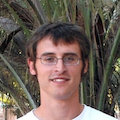
Stephen H. Donaldson (2015-2019)/ Currently in R&D with company Gore Tex
PhD: chemical engineering at UC Santa Barbara (2014)
His work focuses on measuring physical surface interactions in aqueous colloidal, polymeric, and lipid membrane systems. His personal research interests have transitioned towards biophysics, including biological adhesion, membrane fusion, protein-membrane interactions, and ligand-receptor interactions. As a JRC at ENS, he worked at elucidating membrane adhesion and fusion mechanisms in a diverse set of biological systems, with applications such as neurotransmitter release, G-protein coupled receptor signaling, Alzheimer’s disease progression, and fusion proteins.
Selected publications
![]() “Real time intermembrane force measurements and imaging of lipid domain morphology during hemifusion” D. W. Lee, K. Kristiansen, S. H. Donaldson Jr, N. Cadirov, X. Banquy, J. N. Israelachvili, accepted to Nature Communications, April 2015.
“Real time intermembrane force measurements and imaging of lipid domain morphology during hemifusion” D. W. Lee, K. Kristiansen, S. H. Donaldson Jr, N. Cadirov, X. Banquy, J. N. Israelachvili, accepted to Nature Communications, April 2015.
![]() “Developing a general interaction potential for hydrophobic and hydrophilic interactions” S. H. Donaldson Jr, A. Røyne, K. Kristiansen, M. V. Rapp, S. Das, M. A. Gebbie, D. W. Lee, P. Stock, M. Valtiner, J. N. Israelachvili, Langmuir (2015), 31, 2051-2064.
“Developing a general interaction potential for hydrophobic and hydrophilic interactions” S. H. Donaldson Jr, A. Røyne, K. Kristiansen, M. V. Rapp, S. Das, M. A. Gebbie, D. W. Lee, P. Stock, M. Valtiner, J. N. Israelachvili, Langmuir (2015), 31, 2051-2064.
![]() “Asymmetric electrostatic and hydrophobic-hydrophilic interaction forces between mica surfaces and silicone polymer thin films” S. H. Donaldson Jr, S. Das, M. A. Gebbie, M. V. Rapp, L. C. Jones, Y. Roiter, P. H. Koenig, Y. Gizaw, J. N. Israelachvili, ACS Nano (2013), 7 (11), 10094-10104.
“Asymmetric electrostatic and hydrophobic-hydrophilic interaction forces between mica surfaces and silicone polymer thin films” S. H. Donaldson Jr, S. Das, M. A. Gebbie, M. V. Rapp, L. C. Jones, Y. Roiter, P. H. Koenig, Y. Gizaw, J. N. Israelachvili, ACS Nano (2013), 7 (11), 10094-10104.
https://www.linkedin.com/in/stephen-donaldson-a557b399/

Maurizio Fagotti (2015-2017) / Currently permanent PI CNRS, Université Paris-Sud (France)
PhD: University of Pisa (Italy); Postdoc: research assistant in Oxford (UK)
Aster a PhD on the scaling behaviour of the entanglement entropies and the non-equilibrium time evolution of a state after a sudden quench of a global Hamiltonian parameter, Maurizio collaborated as a postdoc with Prof. F. Essler. His research interests: quantum quenches, integrable models, relaxation/thermalisation, entanglement.
Selected Publications
![]() M. Fagotti, “On Conservation Laws, Relaxation and Pre-relaxation after a Quantum Quench”, arXiv:1401.1064 (2014)
M. Fagotti, “On Conservation Laws, Relaxation and Pre-relaxation after a Quantum Quench”, arXiv:1401.1064 (2014)
![]() M. Fagotti and F.H.L. Essler, “Stationary behaviour of observables after a quantum quench in the spin-1/2 Heisenberg XXZ chain”, J. Stat. Mech. (2013) P07012
M. Fagotti and F.H.L. Essler, “Stationary behaviour of observables after a quantum quench in the spin-1/2 Heisenberg XXZ chain”, J. Stat. Mech. (2013) P07012
![]() M. Fagotti and F.H.L. Essler, “Reduced Density Matrix after a Quantum Quench”, Phys. Rev. B 87, 245107 (2013)
M. Fagotti and F.H.L. Essler, “Reduced Density Matrix after a Quantum Quench”, Phys. Rev. B 87, 245107 (2013)
https://www.linkedin.com/in/maurizio-fagotti-b9399141/

Anastasia Fialkov (2013-2015) / Currently Assistant Professor and University Research Fellow at the Institute of Astronomy, Cambridge University (UK)
PhD: Tel Aviv University; Fellowship at the Institute for Theory and Computation, at the Center for Astrophysics, Harvard (US)
After a Phd on cosmological signature of pre-inflationary relics and first stars and their imprints in the 21-cm signal, Anastasia’s research interests remained very broad within theoretical cosmology and astrophysics: 21-cm cosmology, reionization, large-scale structure, cosmology with Fast Radio Bursts, nature of Dark Matter and other topics.
Selected publications
![]() The subtlety of Ly α photons: changing the expected range of the 21-cm signal, Itamar Reis, Anastasia Fialkov, Rennan Barkana, Monthly Notices of the Royal Astronomical Society, Volume 506, Issue 4, pp.5479-5493, October 2021, doi 10.1093/mnras/stab2089
The subtlety of Ly α photons: changing the expected range of the 21-cm signal, Itamar Reis, Anastasia Fialkov, Rennan Barkana, Monthly Notices of the Royal Astronomical Society, Volume 506, Issue 4, pp.5479-5493, October 2021, doi 10.1093/mnras/stab2089
![]() What it takes to measure reionization with fast radio bursts, Stefan Heimersheim, Nina Sartorio, Anastasia Fialkov, Duncan R. Lorimer, eprint arXiv:2107.14242, July 2021
What it takes to measure reionization with fast radio bursts, Stefan Heimersheim, Nina Sartorio, Anastasia Fialkov, Duncan R. Lorimer, eprint arXiv:2107.14242, July 2021
![]() High-redshift radio galaxies: a potential new source of 21-cm fluctuations, Reis, Itamar; Fialkov, Anastasia; Barkana, Rennan, Monthly Notices of the Royal Astronomical Society, Volume 499, Issue 4, pp.5993-6008, December 2020
High-redshift radio galaxies: a potential new source of 21-cm fluctuations, Reis, Itamar; Fialkov, Anastasia; Barkana, Rennan, Monthly Notices of the Royal Astronomical Society, Volume 499, Issue 4, pp.5993-6008, December 2020
![]() First Star-Forming Structures in Fuzzy Cosmic Filaments, Philip Mocz, Anastasia Fialkov, Mark Vogelsberger, Fernando Becerra, Mustafa A. Amin, Sownak Bose, Michael Boylan-Kolchin, Pierre-Henri Chavanis, Lars Hernquist, Lachlan Lancaster, Federico Marinacci, Victor H. Robles, and Jesús Zavala, Phys. Rev. Lett. 123, 141301, October 2019
First Star-Forming Structures in Fuzzy Cosmic Filaments, Philip Mocz, Anastasia Fialkov, Mark Vogelsberger, Fernando Becerra, Mustafa A. Amin, Sownak Bose, Michael Boylan-Kolchin, Pierre-Henri Chavanis, Lars Hernquist, Lachlan Lancaster, Federico Marinacci, Victor H. Robles, and Jesús Zavala, Phys. Rev. Lett. 123, 141301, October 2019
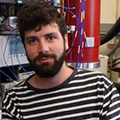
Emmanuel Flurin (2017-2018) / Currently permanent PI, Quantronics - CEA, Saclay (France)
PhD: ENS (France); Postdoc: Berkeley, Prof. Irfan Siddiqi’s group (US)
Both his PhD and postdoc focused on microwave amplification at the quantum limit. As a JRC Emmanuel worked at exploiting original quantum resources at microwave frequencies to enhance the position metrology of a mechanical oscillator.
Selected publications
![]() Observing topological invariant using quantum walk in superconducting circuits. E Flurin, VV Ramasesh, S Hacohen-Gourgy, N Yao, I Siddiqi ; arXiv preprint 1610.03069 (submitted)
Observing topological invariant using quantum walk in superconducting circuits. E Flurin, VV Ramasesh, S Hacohen-Gourgy, N Yao, I Siddiqi ; arXiv preprint 1610.03069 (submitted)
![]() Direct Probe of Topological Invariants Using Bloch Oscillating Quantum Walks. VV Ramasesh, E Flurin, M. Rudner, I Siddiqi, N Yao ; arXiv preprint 1609.09504 (submitted)
Direct Probe of Topological Invariants Using Bloch Oscillating Quantum Walks. VV Ramasesh, E Flurin, M. Rudner, I Siddiqi, N Yao ; arXiv preprint 1609.09504 (submitted)
![]() Simultaneous measurement of non-commuting observables in circuit QED. S Hacohen-Gourgy, L Martin, E Flurin, VV Ramasesh, B Whaley, I Siddiqi ; Nature 538, 491 (2016)
Simultaneous measurement of non-commuting observables in circuit QED. S Hacohen-Gourgy, L Martin, E Flurin, VV Ramasesh, B Whaley, I Siddiqi ; Nature 538, 491 (2016)
 Manuel Gessner (2018-2021) / Currently “La Caixa” Junior Leader, ICFO (Spain)
Manuel Gessner (2018-2021) / Currently “La Caixa” Junior Leader, ICFO (Spain)
PhD: University of Freiburg (Germany); Postdoc: LENS in Florence (Italy)
Manuel works in the fields of quantum information and quantum metrology: he worked in the groups of H.-B. Breuer and A. Buchleitner and later joined A. Smerzi’s theory group, working on interferometry, quantum correlations and Bose-Einstein condensates.
At ENS, Manuel’s worked on quantum precision measurements, addressing in particular the problem of multiple parameters and quantum optical superresolution. He further developed techniques for the detection of quantum correlations and studied many-body physics in Bose-Einstein condensates.
Now at the Institute of Photonic Sciences (ICFO) in Barcelona (Spain), he is “La Caixa” Junior Leader, and works on the intersection of quantum information and metrology, and its applications in optical and atomic systems.
Selected publications
![]() P. Feldmann, C. Klempt, A. Smerzi, L. Santos, M. Gessner, Interferometric Order Parameter for Excited-State Quantum Phase Transitions in Bose-Einstein Condensates, Physical Review Letters 126, 230602 (2021).
P. Feldmann, C. Klempt, A. Smerzi, L. Santos, M. Gessner, Interferometric Order Parameter for Excited-State Quantum Phase Transitions in Bose-Einstein Condensates, Physical Review Letters 126, 230602 (2021).
![]() B. Yadin, M. Fadel, M. Gessner, Metrological complementarity reveals the Einstein-Podolsky-Rosen paradox, Nature Communications 12, 2410 (2021).
B. Yadin, M. Fadel, M. Gessner, Metrological complementarity reveals the Einstein-Podolsky-Rosen paradox, Nature Communications 12, 2410 (2021).
![]() Z. Ren, W. Li, A. Smerzi, M. Gessner, Metrological Detection of Multipartite Entanglement from Young Diagrams, Physical Review Letters 126, 080502 (2021).
Z. Ren, W. Li, A. Smerzi, M. Gessner, Metrological Detection of Multipartite Entanglement from Young Diagrams, Physical Review Letters 126, 080502 (2021).
![]() M. Gessner, C. Fabre, N. Treps, Superresolution limits from measurement crosstalk, Physical ReviewLetters 125, 100501 (2020).
M. Gessner, C. Fabre, N. Treps, Superresolution limits from measurement crosstalk, Physical ReviewLetters 125, 100501 (2020).
![]() M. Gessner, A. Smerzi, L. Pezzè, Multiparameter squeezing for optimal quantum enhancements in sensor networks, Nature Communications 11, 3817 (2020).
M. Gessner, A. Smerzi, L. Pezzè, Multiparameter squeezing for optimal quantum enhancements in sensor networks, Nature Communications 11, 3817 (2020).
![]() L. Pezzè, M. Gessner, P. Feldmann, C. Klempt, L. Santos, A. Smerzi, Heralded Generation of Macroscopic Superposition States in a Spinor Bose-Einstein Condensate, Physical Review Letters 123, 260403 (2019).
L. Pezzè, M. Gessner, P. Feldmann, C. Klempt, L. Santos, A. Smerzi, Heralded Generation of Macroscopic Superposition States in a Spinor Bose-Einstein Condensate, Physical Review Letters 123, 260403 (2019).
For a complete list: https://sites.google.com/view/qinfo/publications
More information: https://sites.google.com/view/qinfo/home
https://www.linkedin.com/in/manuel-gessner-0b78251b6/
 Raphaël Jeanneret (2019-2021) / Currently permanent PI CNRS, ENS Biophysics team
Raphaël Jeanneret (2019-2021) / Currently permanent PI CNRS, ENS Biophysics team
After two fruitful years as a JRC, Raphaël obtained a CNRS permanent position within his Biophysics team at ENS. As an experimental physicist working on micro-organismal systems, his research focuses on active and out-of-equilibrium systems and the biology and ecology of microbes.
His previous postdoctoral experiences include England (with M. Polin and V. Kantsler, University of Warwick) and Spain (Mediterranean Institute for Advanced Studies IMEDEA, group of Idan Tuval), with research on the self-organization of confined micro-emulsions under low Reynolds number flows.
Selected Publications
![]() M. Rieu, T. Vieille, G. Radou, R. Jeanneret, N. Ruiz-Gutierrez, B. Ducos, J.-F. Allemand, and V. Croquette, Parallel, linear, and subnanometric 3D-tracking of microparticles with Stereo Darkfield Interferometry, Sci. Adv, in press (2021)
M. Rieu, T. Vieille, G. Radou, R. Jeanneret, N. Ruiz-Gutierrez, B. Ducos, J.-F. Allemand, and V. Croquette, Parallel, linear, and subnanometric 3D-tracking of microparticles with Stereo Darkfield Interferometry, Sci. Adv, in press (2021)
![]() J. Font-Munoz∗, R. Jeanneret∗, J. Arrieta, S. Angl`es, A. Jordi, I. Tuval and G. Basterretxea, Collective sinking promotes selective cell pairing in planktonic pennate diatoms, Proc. Nat. Acad. Sci. USA 116, 15997-16002 (2019)
J. Font-Munoz∗, R. Jeanneret∗, J. Arrieta, S. Angl`es, A. Jordi, I. Tuval and G. Basterretxea, Collective sinking promotes selective cell pairing in planktonic pennate diatoms, Proc. Nat. Acad. Sci. USA 116, 15997-16002 (2019)
![]() R. Jeanneret, D.O. Pushkin and M. Polin, Confinement enhances the diversity of microbial flow fields, Phys. Rev. Lett. 123, 248102 (2019)
R. Jeanneret, D.O. Pushkin and M. Polin, Confinement enhances the diversity of microbial flow fields, Phys. Rev. Lett. 123, 248102 (2019)
![]() R. Jeanneret, D. O. Pushkin, V. Kantsler, and M. Polin, Entrainment dominates the interaction of microalgae with micron-sized objects, Nat. Commun. 7, 12518 (2016)
R. Jeanneret, D. O. Pushkin, V. Kantsler, and M. Polin, Entrainment dominates the interaction of microalgae with micron-sized objects, Nat. Commun. 7, 12518 (2016)
More information: https://raphjeanneret.wordpress.com
https://www.linkedin.com/in/rapha%C3%ABl-jeanneret-221b6926/
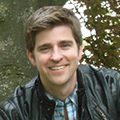
Michael Köpf (2013-2015) / Currently AI & Cloud consultant for company Consilica (Köln, Germany)
PhD: University of Münster (Germany); Postdoc: Human Frontier Science Program, Technion in Haifa (Israel)
As a mathematically inclined student of physics, Michael was attracted to the science of nonlinear dynamics and self-organization. He focused on theoretical model of spontaneous formation of nanoscopic stripe patterns in coating processes using mono-molecular layers. This research project allowed to bridge fundamental science and technological application.
Michael’s interest later shifted towards the ultimate form of self-organization: Life. He worked on the mathematical description of biological and bio-mimetic materials in various contexts. In his ENS project "Growth and Development in Biological Systems: From Bacteria to Olive Trees" he worked on growth and development on the various different scales of life.
More information:
http://www.michaelkoepf.de/
https://www.linkedin.com/in/michael-k%C3%B6pf-consilica/
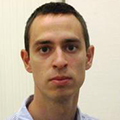
Andrei Lazanu (2018-2021)
BA & MMath: Mathematical Tripos at the University of Cambridge, Gonville and Caius College; PhD: DAMTP, Prof. P. Shellard, University of Cambridge; Postdoc: InDark fellow at INFN (Padua, Italy)
As a theoretical physicist he studies the effects of topological defects on the Cosmic Microwave Background and the inflationary bispectrum of the large-scale structure of the Universe. He also focused on the analytical modelling of the matter bispectrum of large-scale structure and on obtaining forecasts for primordial non-Gaussianity.
At ENS, he developed analytical and numerical techniques to model the galaxy bispectrum in order to place stringent constraints on cosmological parameters. These involve both work to model the matter bispectrum towards the nonlinear regime, as well as accurate large-scale studies for the galaxy bispectrum. Part of the work is being pursued in the framework of the Euclid Consortium. He also studies models of dark energy and modified gravity, and in particular he focuses on employing three-point correlation functions to constrain parameters of these models.
Selected publications
![]() Extracting cosmological parameters from N-body simulations using machine learning techniques, Andrei Lazanu, arXiv: 2106.11061 (to be published soon)
Extracting cosmological parameters from N-body simulations using machine learning techniques, Andrei Lazanu, arXiv: 2106.11061 (to be published soon)
![]() The reach of next-to-leading-order perturbation theory for the matter bispectrum, D. Alkhanishvili, C. Porciani, E. Sefusatti, M. Biagetti, A. Lazanu, A. Oddo, V. Yankelevich, arXiv: 2107.08054 (to be published soon)
The reach of next-to-leading-order perturbation theory for the matter bispectrum, D. Alkhanishvili, C. Porciani, E. Sefusatti, M. Biagetti, A. Lazanu, A. Oddo, V. Yankelevich, arXiv: 2107.08054 (to be published soon)
![]() Scale-dependence in DHOST inflation, Philippe Brax, Andrei Lazanu, JCAP 08 (2021) 061, arXiv: 2106.09319, doi: 10.1088/1475-7516/2021/08/061
Scale-dependence in DHOST inflation, Philippe Brax, Andrei Lazanu, JCAP 08 (2021) 061, arXiv: 2106.09319, doi: 10.1088/1475-7516/2021/08/061
![]() The two and three-loop matter bispectrum in perturbation theories, A. Lazanu, M. Liguori, JCAP 1804 (2018) no.04, 055
The two and three-loop matter bispectrum in perturbation theories, A. Lazanu, M. Liguori, JCAP 1804 (2018) no.04, 055
![]() Constraining primordial non-Gaussianity with bispectrum and power spectrum from upcoming optical and radio surveys, D. Karagiannis, A. Lazanu, M. Liguori, A. Raccanelli, N. Bartolo, L. Verde, Mon.Not.Roy.Astron.Soc. 478 (2018) no.1, 1341-1376
Constraining primordial non-Gaussianity with bispectrum and power spectrum from upcoming optical and radio surveys, D. Karagiannis, A. Lazanu, M. Liguori, A. Raccanelli, N. Bartolo, L. Verde, Mon.Not.Roy.Astron.Soc. 478 (2018) no.1, 1341-1376
More information: https://scholar.google.com/citations?user=UNWdrKYAAAAJ&hl=en
https://www.linkedin.com/in/andrei-lazanu-aa433a1b2/

Fedor Levkovich-Maslyuk (2017-2020)/ Currently Post-doctoral fellow at IPhT, Saclay University (France)
MS: Moscow State University; PhD: King’s College London (UK); Postdoc: Nordita Institute (Stockholm)
Fedor focuses on understanding the dynamics of strongly interacting quantum field theories. His work contributed to the understanding of the exact spectrum in several 3d and 4d models, giving new predictions for realistic models of strong nuclear forces.
Selected publications
![]() A. Cavaglia, N. Gromov, F. Levkovich-Maslyuk, "Quantum spectral curve and structure constants in N=4 SYM: cusps in the ladder limit", JHEP 1810 (2018) 060 [arXiv:1802.04237]
A. Cavaglia, N. Gromov, F. Levkovich-Maslyuk, "Quantum spectral curve and structure constants in N=4 SYM: cusps in the ladder limit", JHEP 1810 (2018) 060 [arXiv:1802.04237]
![]() M. Guica, F. Levkovich-Maslyuk, K. Zarembo, "Integrability in dipole-deformed N=4 super Yang–Mills", J.Phys. A50 (2017) no.39, 394001 [arXiv:1706.07957]
M. Guica, F. Levkovich-Maslyuk, K. Zarembo, "Integrability in dipole-deformed N=4 super Yang–Mills", J.Phys. A50 (2017) no.39, 394001 [arXiv:1706.07957]
![]() N. Gromov, F. Levkovich-Maslyuk, G. Sizov, "New Construction of Eigenstates and Separation of Variables for SU(N) Quantum Spin Chains", JHEP 1709 (2017) 111 [arXiv:1610.08032]
N. Gromov, F. Levkovich-Maslyuk, G. Sizov, "New Construction of Eigenstates and Separation of Variables for SU(N) Quantum Spin Chains", JHEP 1709 (2017) 111 [arXiv:1610.08032]
More information: https://scholar.google.com/citations?user=-vFwZfMAAAAJ&hl=en
https://orcid.org/0000-0003-4159-9358
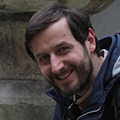
Leonardo Mazza (2015-2018) / Currently Maître de conférence, Université Paris-Sud (France)
PhD: Max-Planck-Institut of Quantum Optics (2012)
Leonardo works on ultra-cold atoms and quantum simulations, with a strong focus on topological phases of matter. He held his first post-doctoral position in Pisa (group of R. Fazio).
His research topics include interactions in cold atomic gases coupled to synthetic gauge potentials, possible identification of topological phases of matter in such setups, Majorana fermions in low-dimensional superconductors. Employing numerical techniques especially suited for one-dimensional systems, he has studied several aspects of their non-equilibrium physics, from energy transport to dissipation.
Selected publications
![]() Localized Majorana-like modes in a number conserving setting: An exactly solvable model. Iemini, Mazza, Rossini, Diehl and Fazio, arXiv:1504.04230 (2015).
Localized Majorana-like modes in a number conserving setting: An exactly solvable model. Iemini, Mazza, Rossini, Diehl and Fazio, arXiv:1504.04230 (2015).
![]() Magnetic crystals and helical liquids in alkaline-earth fermionic gases. Barbarino, Taddia, Rossini, Mazza and Fazio, arXiv:1504.00164 (2015).
Magnetic crystals and helical liquids in alkaline-earth fermionic gases. Barbarino, Taddia, Rossini, Mazza and Fazio, arXiv:1504.00164 (2015).
![]() Robustness of quantum memories based on Majorana zero modes. Mazza, Rizzi, Lukin and Cirac, PRB 88, 205142 (2013).
Robustness of quantum memories based on Majorana zero modes. Mazza, Rizzi, Lukin and Cirac, PRB 88, 205142 (2013).
More information: https://sites.google.com/site/leonardmaz/
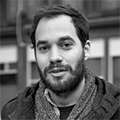
Joshua McGraw (2015-2017) / Currently permanent PI CNRS, ESPCI (France)
PhD: at McMaster University (Canada) in 2012; Postdoc: Saarland University (Germany),
As an experimental soft condensed matter physicist, Josh worked in confined polymer physics, organic glasses, and thin film flows. He later studied the slip hydrodynamic boundary condition. As a JRC Josh accentuated his research at the nanoscale, along with a move towards elastohydrodynamics - a rising field crucial to soft and bio systems.
Selected publications
![]() S. Haefner, M. Benzaquen, O. Bäumchen, T. Salez, R. Peters, J.D. McGraw, K. Jacobs, E. Raphaël, K. Dalnoki-Veress, Influence of Slip on the Plateau-Rayleigh Instability on a Fibre, Nature Communications (in press); arXiv:1501.02194.
S. Haefner, M. Benzaquen, O. Bäumchen, T. Salez, R. Peters, J.D. McGraw, K. Jacobs, E. Raphaël, K. Dalnoki-Veress, Influence of Slip on the Plateau-Rayleigh Instability on a Fibre, Nature Communications (in press); arXiv:1501.02194.
![]() J.D. McGraw, O. Bäumchen, M. Klos, S. Haefner, M. Lessel, S. Backes and K. Jacobs, Nanofluidics of thin polymer films: Linking the slip boundary condition at solid-liquid interfaces to macroscopic pattern formation and microscopic interfacial properties, Advances in Colloid and Interface Science, 210 (2014) 13.
J.D. McGraw, O. Bäumchen, M. Klos, S. Haefner, M. Lessel, S. Backes and K. Jacobs, Nanofluidics of thin polymer films: Linking the slip boundary condition at solid-liquid interfaces to macroscopic pattern formation and microscopic interfacial properties, Advances in Colloid and Interface Science, 210 (2014) 13.
![]() Y. Chai, T. Salez, J.D. McGraw, M. Benzaquen, K. Dalnoki-Veress, E. Raphaël, J. Forrest, A Direct Quantitative Measure of Surface Mobility in a Glassy Polymer, Science, 343 (2014) 994.
Y. Chai, T. Salez, J.D. McGraw, M. Benzaquen, K. Dalnoki-Veress, E. Raphaël, J. Forrest, A Direct Quantitative Measure of Surface Mobility in a Glassy Polymer, Science, 343 (2014) 994.
https://www.linkedin.com/in/joshua-mcgraw-8708b317b/
 Achilleas Passias (2019-2021)/ University of Athens (Greece)
Achilleas Passias (2019-2021)/ University of Athens (Greece)
PhD: King’s College London (UK); Postdoc: University of Milano-Bicocca, Uppsala University
Achilleas is a theoretical physicist, whose research focuses on the duality between strongly coupled quantum field theories and theories of gravity. He now works at the University of Athens (Greece).
Selected Publications
![]() N=(2,2) AdS(3) from D3-branes wrapped on Riemann surfaces, arXiv:2107.13562; with C. Couzens and N. Macpherson
N=(2,2) AdS(3) from D3-branes wrapped on Riemann surfaces, arXiv:2107.13562; with C. Couzens and N. Macpherson
![]() On supersymmetric AdS(3) solutions of Type II, J. High Energy Phys. 08 (2021) 168; with D. Prins
On supersymmetric AdS(3) solutions of Type II, J. High Energy Phys. 08 (2021) 168; with D. Prins
![]() On AdS(3) solutions of Type IIB, J. High Energy Phys. 05 (2020) 048; with D. Prins
On AdS(3) solutions of Type IIB, J. High Energy Phys. 05 (2020) 048; with D. Prins
More information: https://inspirehep.net/authors/1263931
https://www.linkedin.com/in/achilleaspassias/
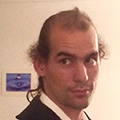
Stéphane Perrard (2018-2022) / Currently permanent PI CNRS at PMMH (ESPCI) (France)
As an experimental physicist in non-linear Physics and fluid dynamics, Stéphane spent four years as JRC. After his studies at Ecole normale supérieure of Paris & Lyon, and a PhD with Y. Couder and E. Fort (university Paris-Diderot), he joined the James Franck Institute (University of Chicago) and Pr. W. Irvine, studying hydrodynamics turbulence in inhomogeneous and un-stationnary situations. In 2017, through a joined position between University Paris-Sud and Ecole Polytechnique he studied generation of waves by the wind.
He began his permanent PI position at the PMMH of ESPCI (Laboratoire de Physique et Mécanique des Milieux Hétérogènes) in 2022.
Selected publications
![]() Creation of an isolated turbulent blob sustained by vortex ring injection, T Matsuzawa, N Mitchell, S Perrard, Bulletin of the American Physical Society (2021)
Creation of an isolated turbulent blob sustained by vortex ring injection, T Matsuzawa, N Mitchell, S Perrard, Bulletin of the American Physical Society (2021)
![]() Effect of a weak current on wind-generated waves in the wrinkle regime, C Nové-Josserand, S Perrard, A Lozano-Durán, M Benzaquen, ..., Physical Review Fluids 5 (12), 124801 (2020)
Effect of a weak current on wind-generated waves in the wrinkle regime, C Nové-Josserand, S Perrard, A Lozano-Durán, M Benzaquen, ..., Physical Review Fluids 5 (12), 124801 (2020)
![]() Bubble deformation by a turbulent flow, S Perrard, A Rivière, W Mostert, L Deike, arXiv preprint arXiv:2011.10548 (2020)
Bubble deformation by a turbulent flow, S Perrard, A Rivière, W Mostert, L Deike, arXiv preprint arXiv:2011.10548 (2020)
![]() Surface waves along liquid cylinders. Part 1. Stabilising effect of gravity on the Plateau–Rayleigh instability, CT Pham, S Perrard, G Le Doudic, Journal of Fluid Mechanics 891 (2020)
Surface waves along liquid cylinders. Part 1. Stabilising effect of gravity on the Plateau–Rayleigh instability, CT Pham, S Perrard, G Le Doudic, Journal of Fluid Mechanics 891 (2020)
![]() Wind Wave Generation: Turbulent Windprint below the Wave Onset and its Link with OM Phillips 1957 Theory, S Perrard, C Nové-Josserand, A Lozano-Duran, M Rabaud, ..., Ocean Sciences Meeting (2020)
Wind Wave Generation: Turbulent Windprint below the Wave Onset and its Link with OM Phillips 1957 Theory, S Perrard, C Nové-Josserand, A Lozano-Duran, M Rabaud, ..., Ocean Sciences Meeting (2020)
More information: https://scholar.google.fr/citations?user=drKqDrUAAAAJ&hl=fr

Olga Petrova (2016-Aug 2018) / Currently Machine Learning Engineer with company Scaleway (France)
PhD: Johns Hopkins University (USA); Postdoc: Max Planck Institute for the Physics of Complex Systems (Germany)
As a theoretical condensed matter physicist Olga focused on various aspects of quantum magnetism. As a JRC she collaborated on the studies of quantum spin liquids with N. Regnault.
Selected publications
![]() "Coulomb potential V (r)= 1/r problem on the Bethe lattice", O Petrova, R Moessner, Physical Review E 93 (1), 012115 (2016)
"Coulomb potential V (r)= 1/r problem on the Bethe lattice", O Petrova, R Moessner, Physical Review E 93 (1), 012115 (2016)
![]() "Hydrogenic states of monopoles in diluted quantum spin ice", O Petrova, R Moessner, SL Sondhi, Physical Review B 92 (10), 100401 (2015)
"Hydrogenic states of monopoles in diluted quantum spin ice", O Petrova, R Moessner, SL Sondhi, Physical Review B 92 (10), 100401 (2015)
![]() "Projective symmetry of partons in the Kitaev honeycomb model", P Mellado, O Petrova, O Tchernyshyov, Physical Review B 91 (4), 041103 (2015)
"Projective symmetry of partons in the Kitaev honeycomb model", P Mellado, O Petrova, O Tchernyshyov, Physical Review B 91 (4), 041103 (2015)
https://www.linkedin.com/in/olga-p-petrova/
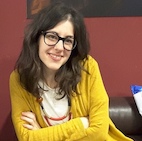
Valentina Ros (2019-2020)/ currently permanent PI at LPTMS (Orsay, France)
PhD: International School for Advanced Studies (SISSA) in Trieste (Italy); Postdoc: Institute of Theoretical Physics, CEA in Saclay (France)
She is interested in quantum and classical disordered systems, ergodicity breaking and out-of-equilibrium dynamics. Her research activity focuses on quantum localization phenomena, high-dimensional random landscapes and glassy systems.
Statistical and Nonlinear Physics Early Career Prize of the European Physical Society (2019).
Selected Publications
![]() Distribution of rare saddles in the p-spin energy landscape, Journal of Physics A: Mathematical and Theoretical 53, 125002 (2020).
Distribution of rare saddles in the p-spin energy landscape, Journal of Physics A: Mathematical and Theoretical 53, 125002 (2020).
![]() Complex energy landscapes in spiked-tensor and simple glassy models: ruggedness, arrangements of local minima and phase transitions, with G. Ben Arous, G. Biroli and C. Cammarota, Physical Review X 9, 011003 (2019).
Complex energy landscapes in spiked-tensor and simple glassy models: ruggedness, arrangements of local minima and phase transitions, with G. Ben Arous, G. Biroli and C. Cammarota, Physical Review X 9, 011003 (2019).
![]() Remanent magnetization: signature of Many-Body Localization, with M. Mueller, Physical Review Letters 118, 237202 (2017).
Remanent magnetization: signature of Many-Body Localization, with M. Mueller, Physical Review Letters 118, 237202 (2017).
https://www.linkedin.com/in/valentina-ros-6199951b7/
https://vale1925.wixsite.com/vros

Julian Struck (2017-2021) / Currently Systems Engineer with Tesat-Spacecom (Germany)
https://www.tesat.de/
PhD: Prof. Dr. K. Sengstock, University of Hamburg (Germany), 2013; Postdoc: Massachusetts Institute of Technology (MIT), Prof. Dr. M. Zwierlein’s group, 2014
First working on bosonic quantum gases, in artificial gauge fields and driven optical lattices, his research includes the field of strongly interacting, ultracold Fermi gases focused on Fermi Liquid behavior, hydrodynamics, phonon decay and short-range correlations.
As a JRC at LKB, Julian conceived, planned and supervised pioneering experiments on individually resolved ultracold atomic Fermi gases in the 1D regime and 1D-3D crossover. His studies covered a broad variety of topics ranging from thermodynamics to out-of-equilibrium phenomena and transport with strong interactions.
Selected publications
![]() C. De Daniloff, M. Tharrault, C. Enesa, C. Salomon, F. Chevy, T. Reimann and J. Struck. In Situ Thermometry of Fermionic Cold-Atom Quantum Wires. Phys. Rev. Lett. 127:113602 (2021).
C. De Daniloff, M. Tharrault, C. Enesa, C. Salomon, F. Chevy, T. Reimann and J. Struck. In Situ Thermometry of Fermionic Cold-Atom Quantum Wires. Phys. Rev. Lett. 127:113602 (2021).
![]() P. B. Patel, Z. Yan, B. Mukherjee, R. J. Fletcher, J. Struck and M. W. Zwierlein. Universal sound diffusion in a strongly interacting Fermi gas. Science 370:1222-1226 (2020)
P. B. Patel, Z. Yan, B. Mukherjee, R. J. Fletcher, J. Struck and M. W. Zwierlein. Universal sound diffusion in a strongly interacting Fermi gas. Science 370:1222-1226 (2020)
https://science.sciencemag.org/content/370/6521/1222/tab-article-info
![]() Z. Yan, P. B. Patel, B. Mukherjee, R. J. Fletcher, J. Struck and M. W. Zwierlein. Boiling a Unitary Fermi Liquid. Physical Review Letters 122:093401 (2019)
Z. Yan, P. B. Patel, B. Mukherjee, R. J. Fletcher, J. Struck and M. W. Zwierlein. Boiling a Unitary Fermi Liquid. Physical Review Letters 122:093401 (2019)
![]() B. Mukherjee, Z. Yan, P. B. Patel, Z. Hadzibabic, T. Yefsah, J. Struck and M. W. Zwierlein. Homogeneous Atomic Fermi Gases. Physical Review Letters 118:123401 (2017).
B. Mukherjee, Z. Yan, P. B. Patel, Z. Hadzibabic, T. Yefsah, J. Struck and M. W. Zwierlein. Homogeneous Atomic Fermi Gases. Physical Review Letters 118:123401 (2017).
![]() J. Struck, M. Weinberg, C. Ölschläger, P. Windpassinger, J. Simonet, K. Sengstock, R. Höppner, P. Hauke, A. Eckardt, M. Lewenstein and L. Mathey. Engineering Ising-XY spin-models in a triangular lattice using tunable artificial gauge fields. Nature Physics 9:738–743 (2013).
J. Struck, M. Weinberg, C. Ölschläger, P. Windpassinger, J. Simonet, K. Sengstock, R. Höppner, P. Hauke, A. Eckardt, M. Lewenstein and L. Mathey. Engineering Ising-XY spin-models in a triangular lattice using tunable artificial gauge fields. Nature Physics 9:738–743 (2013).
![]() J. Struck, C. Ölschläger, M. Weinberg, P. Hauke, J. Simonet, A. Eckardt, M. Lewenstein, K. Sengstock and P. Windpassinger. Tunable Gauge Potential for Neutral and Spinless Particles in Driven Optical Lattices. Physical Review Letters 108:225304 (2012).
J. Struck, C. Ölschläger, M. Weinberg, P. Hauke, J. Simonet, A. Eckardt, M. Lewenstein, K. Sengstock and P. Windpassinger. Tunable Gauge Potential for Neutral and Spinless Particles in Driven Optical Lattices. Physical Review Letters 108:225304 (2012).
More information: http://www.lkb.upmc.fr/ultracoldfermigases/julian-struck/
https://www.linkedin.com/in/julianstruck/